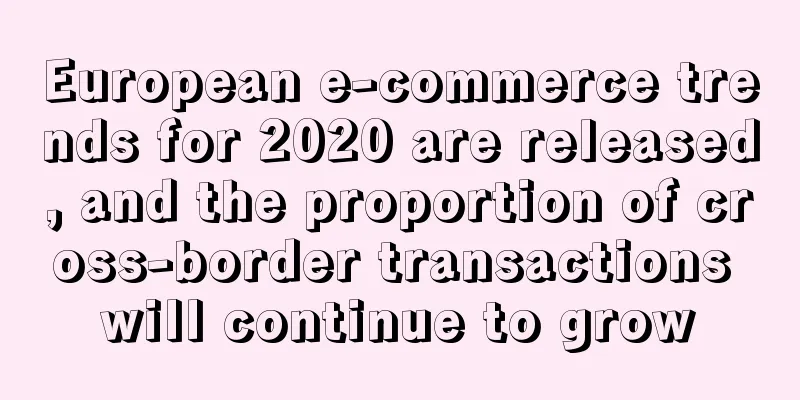European e-commerce trends for 2020 are released, and the proportion of cross-border transactions will continue to grow

|
Recently, marketing company Salesforce released its own shopping index , revealing several major trends in the development of European e-commerce. We can also combine the latest 2021 European cross-border B2C e-commerce market report released by market research firm ResearchAndMarkets to look at the situation of cross-border e-commerce in Europe from the data.
Trend 1 : Necessities and health become the focus of purchases Another key trend is that European shoppers are choosing to prioritise spending on essentials , particularly food and drink , over health and beauty.
The food category is growing rapidly, even reaching a growth rate of 137% . In addition , health and wellness is also on the rise , becoming the second fastest growing e-commerce sector in Europe last year with a growth rate of 112% .
Trend 2 : Social shopping channel orders surge The rapid growth of social commerce in the past year is well known . However, in the second quarter of last year, orders from social recommendation channels in Europe increased by 87% year-on-year, almost twice that of the first quarter. This shows that the conversion rate on social platforms is surprisingly high.
Combined with the trend of social live streaming, it can be said that this part of social traffic is undoubtedly very attractive to businesses.
Trend 3 : The proportion of cross-border e-commerce continues to grow According to Salesforce data, Italy had the fastest e-commerce growth in 2020 , reaching 81%. As the fifth largest e-commerce market in Europe , Italy, with a smaller population, has achieved rapid growth. However, the growth rates of the largest market, the United Kingdom, and the second largest market, France, are also among the top three . E-commerce in the United Kingdom grew by 61%, and in France by 58%.
On the other hand, Germany is the slowest growing country in Europe, with an overall growth rate of 22% by 2020. In the report of ResearchAndMarkets , the proportion of cross-border consumers in Germany is the most stable , with about 30-40% of online shoppers choosing cross-border goods , while in Italy , the proportion of cross-border consumers reaches 60% .
In a previous survey by ResearchAndMarkets on global cross-border e-commerce, he believed that the development speed of cross-border B2C e-commerce business varies in different countries around the world . However, in Europe , only Italy has most e-commerce businesses that are cross-border businesses. This is the opposite of other European countries.
The European online cross-border market was worth 146 billion euros in 2020, up 35% from a year ago. The cross-border share accounts for 25.5% of total European online sales . However, this proportion is still increasing slowly and there is still a lot of room for growth. E-commerce market |
<<: The handling fee is as low as 2.9%! WeMef Korea implements a fixed fee system
>>: Microsoft to invest $1 billion in Malaysia to build regional data center
Recommend
What is Daily Harvest? Daily Harvest Review, Features
Founded in 2015, Daily Harvest is a frozen fresh ...
What is BigSellerIT_ERP? BigSellerIT_ERP Review, Features
BigSellerIT_ERP system can help users avoid tediou...
Amazon is piloting a new program that automatically modifies sellers’ listings
According to sellers’ feedback, Amazon is working...
Shopee is amazing! It received 2.8 billion orders in 2020, with a GMV of US$35.4 billion
Shopee's total orders surged 132.8% in 2020 J...
What is Volusion? Volusion Review, Features
Founded in 1999, Volusion is a service platform th...
What is Datong International Shipping Co., Ltd.? Datong International Shipping Co., Ltd. Review, Features
Datong International Shipping Co., Ltd. started c...
What is Dehengshun Supply Chain? Dehengshun Supply Chain Review, Features
Dehengshun Supply Chain is a company dedicated to ...
Shopee advances digital retail plans in Southeast Asia
According to a report by foreign media Tech Wire ...
Is spring coming for sellers? Amazon is under pressure again, and the US has enacted laws to prohibit platforms from favoring self-operated businesses
Some time ago, the United States launched a new r...
Toothpaste sales surge! The epidemic is a boon to Japan's oral care market
It is reported that due to the epidemic, Japan cl...
What is Acquco? Acquco Review, Features
Founded in 2020, Acquco is an agency-backed acquir...
Following the United States, South Korea's Coupang will open overseas direct purchase services for Chinese products
It is reported that Coupang's China Jikgu pro...
Fastest delivery to six European and American countries in 5 days! Cainiao launches express product to optimize "end-to-end" fulfillment service
On July 28 , at the 2022 Cainiao Open Week - Inte...
Cross-border e-commerce ERP is booming, with cumulative financing exceeding 2.5 billion yuan in the first half of the year
Recently, cross-border e-commerce service provide...
What is Zhuge Selection? Zhuge Selection Review, Features
Zhuge Selection is an intelligent product selecti...









